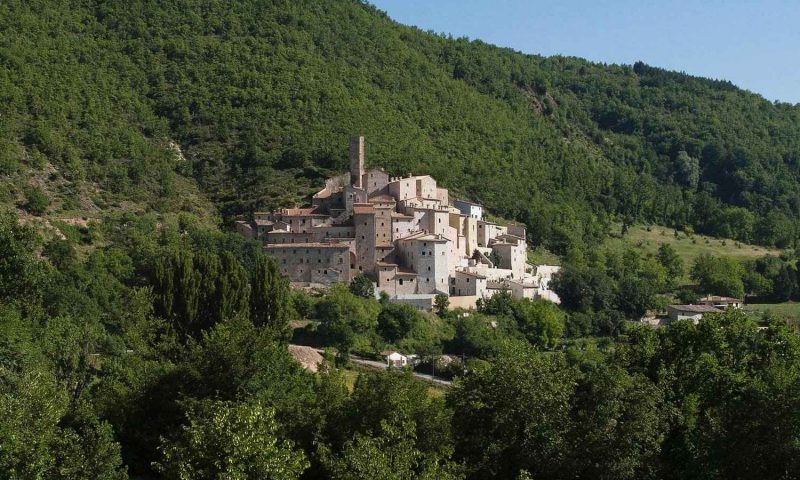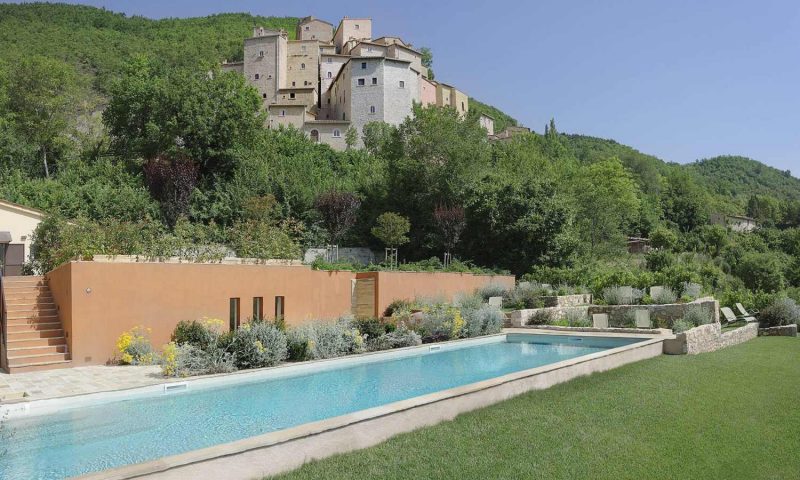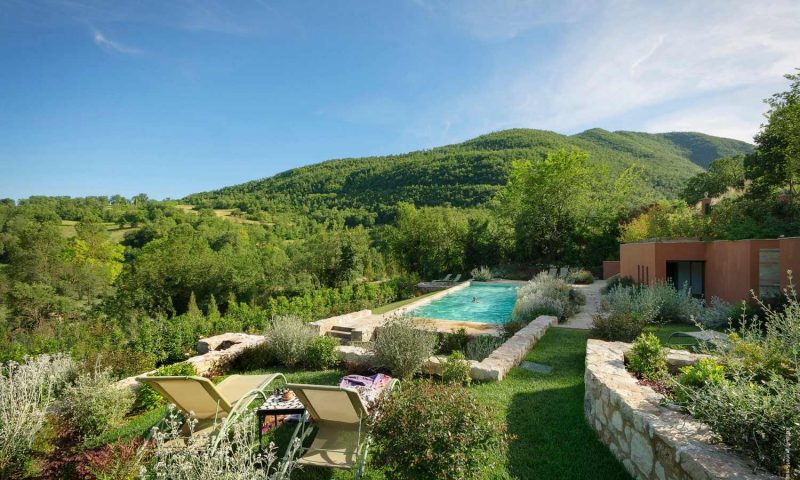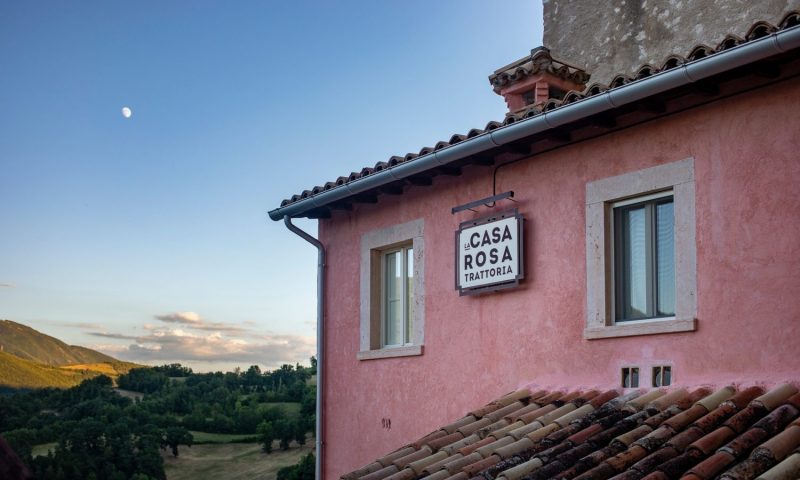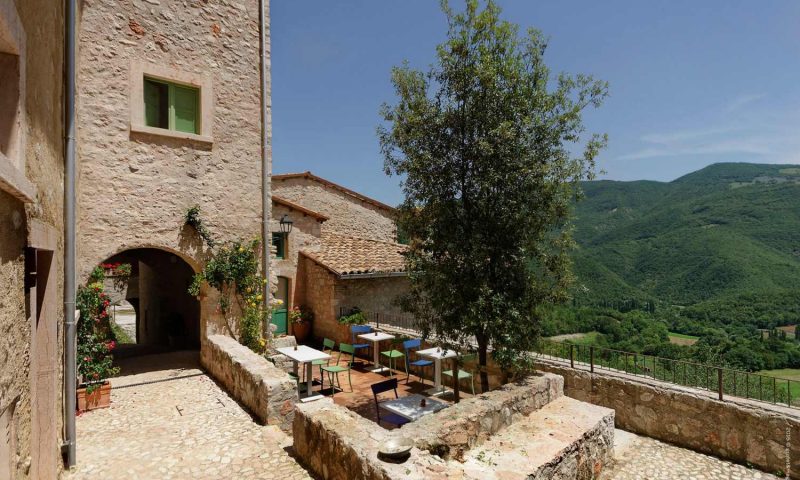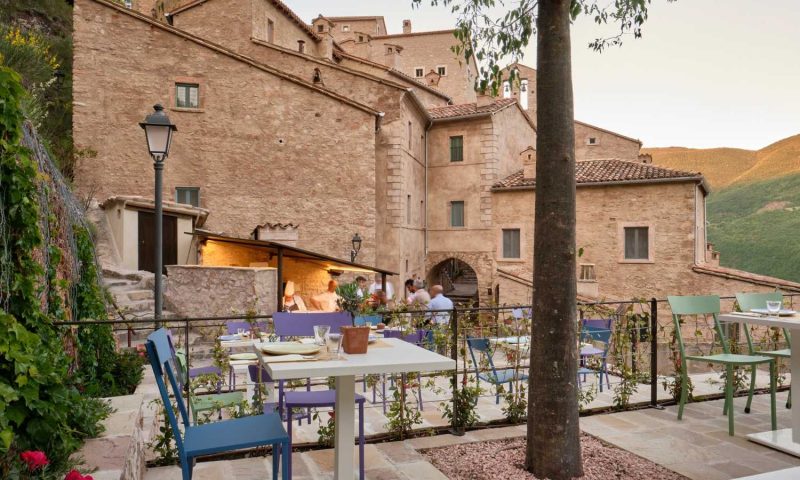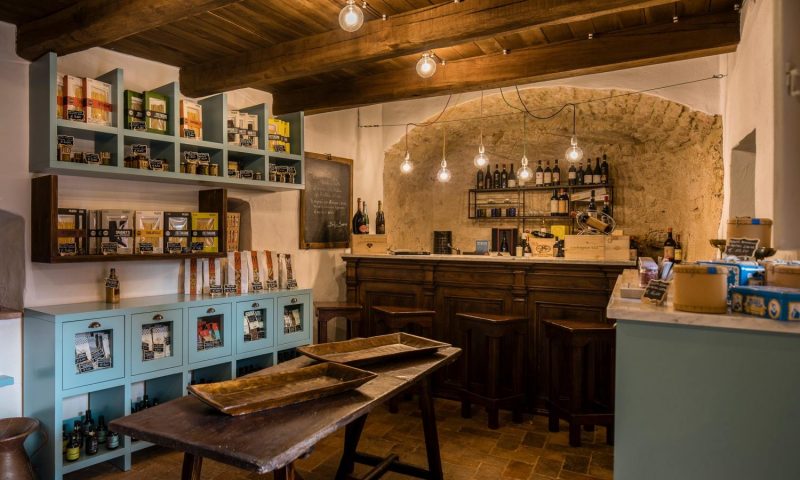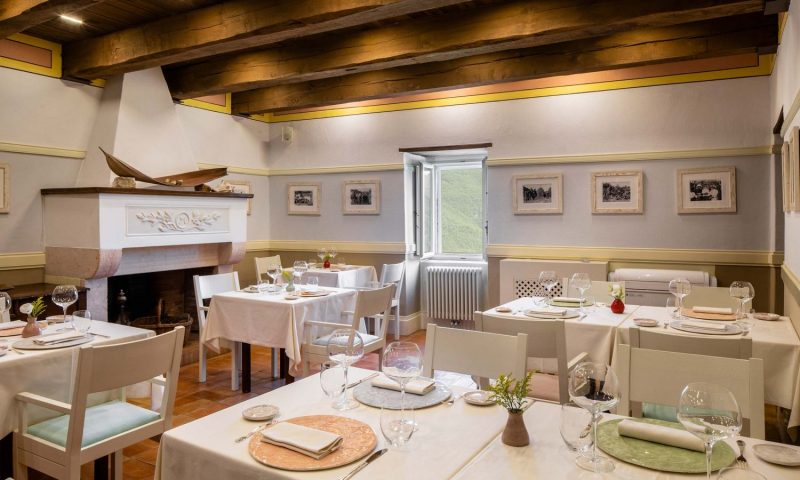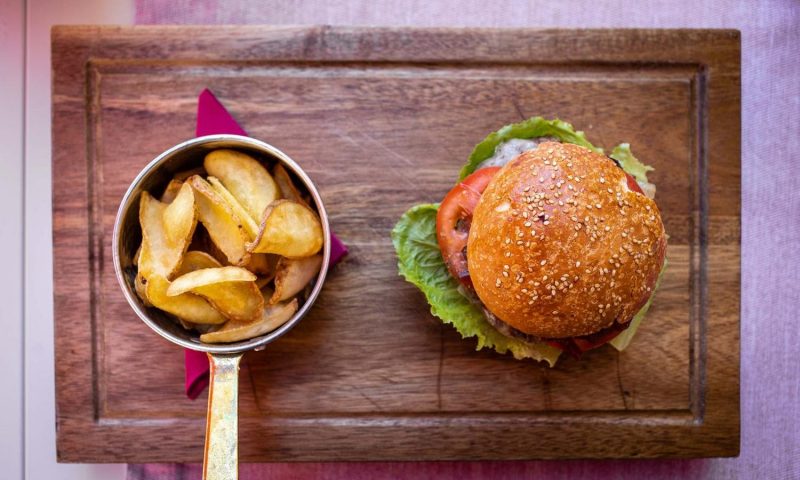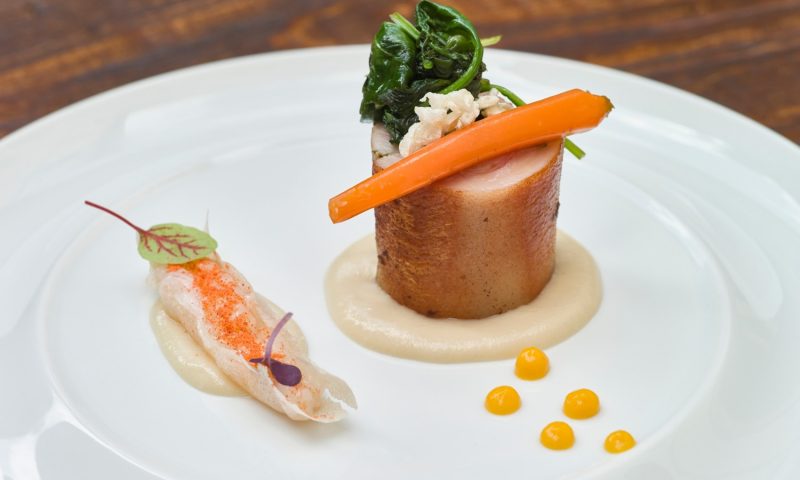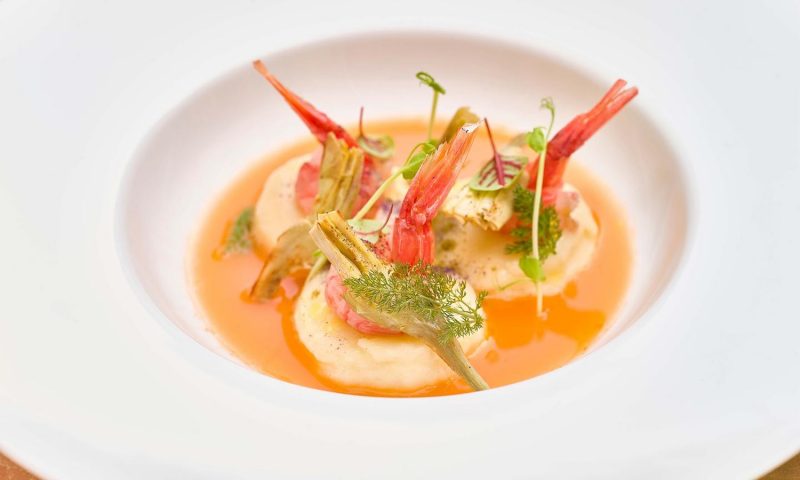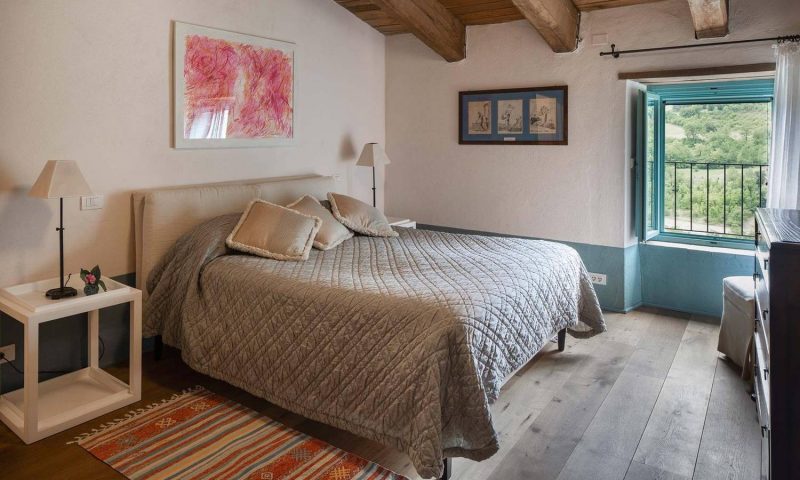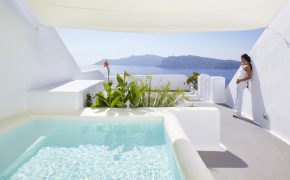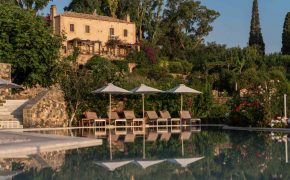A space to experience time. The time of history, the time of memory. This is where we find our space, redesign our perception of time. Today.
To gather together and make new friends. Every doorway in the village hides a tidbit of history, from the exhibition galleries to the ancient SS. Annunziata church. Every doorway in the borgo reveals fragments of its past and offers intriguing perspectives.
In 1979, photographer and architect Norman F. Carver Jr., author of the book “Borghi Collinari Italiani” (Italian Hilltowns), defined Castello di Postignano as the archetype of Italian villages. Positioned at a strategic point in the Vigi Valley, its history begins in the 9th century.
IX-X CENTURY AD – 1611
The village was founded and built by its own inhabitants, mainly farmers and craftsmen, with the function of a castrum, or control post. This is why the definition of Castle is in the name and an observation tower is sited at the highest point of the hillside on which it stands.
Postignano’s position was of great strategic importance, being exactly at the crossroads between Spoleto, Norcia, Foligno and Assisi. During the following centuries, the village experienced a remarkable period of economic stability, being a key centre for the processing and trade of iron and hemp in Umbria. In 1611, the population totalled 235 inhabitants.
1963 – 1979
After progressive abandonment, the last eight families living at Castello di Postignano left their homes in 1963 due to the risk of collapse. Although it was by then deserted, the village never lost its soul.
American photographer and architect Norman F. Carver Jr. realised this, and placed a picture of Postignano on the cover of his 1979 book “Italian Hilltowns”. His work rekindled interest in Italian villages, promoting the appreciation of their history.
1994 – 2014
The project to restore the village began in 1994, with the acquisition of all the land and buildings that were part of it. After about 250 deeds were drawn up, work developed until it was interrupted by an earthquake in 1997.
Finally resuming in 2007 with the addition of the landscape and architectural protection order requested by the property and issued by the Ministry of Cultural Heritage and the Region of Umbria. Gradually, building after building, the village has returned to being the splendid place it once was, faithful to its soul and history.
FROM 2014
Castello di Postignano is a living village again, with restaurants, museums, shops and the SS. Annunziata church where conferences, events and concerts are held. The hamlet houses have been converted into suites that host tourists from all over the world.
ROOMS & SUITES
The ancient hamlet homes, restored also thanks to the memories of its original inhabitants, have been modelled over the centuries, in a constant dialogue with the rural community, the territory and the surrounding architecture.
The harmony thus achieved has been expressed in different living solutions, all equally characterised – in their contemporary interpretation – by great care for authenticity and detail. We are available to help you find your space in the hamlet.
PRESTIGE SUITE
The Prestige suites, in terms of location, size and outer spaces, are the ultimate expression of our hospitality offering. Houses built over the centuries in harmony with the landscape, spacious, with glimpses seeping into the rooms through windows, with terraces to bathe in light. Today we simply call it beauty.
DELUXE SUITE
Our De Luxe suites are very spacious and comfortable. They offer welcoming solutions suited to a family too, in the spirit of attention to detail and comfort. Spacious rooms, built over the centuries around the needs of farming families, transformed into space to be shared by today’s families.
The view that sweeps as far as the horizon, the sounds of nature, of footsteps and voices in the village that reach discreetly through an open window, resulting in an environment where one can pause in calmness, to think, imagine, dream.
JUNIOR SUITE
Our junior suites offer ample space where books, paintings and handcrafted textiles provide a special warmth to the rooms, combined with all modern comforts.
Within the houses of the hamlet: thick walls, fireplaces, niches and windows open onto the hills, articulating the wide spaces and the uneven levels typical of traditional rural living. The attention to detail, the welcome, the comfort of today.
LA TAVOLA ROSSA
The creativity, taste and words by chef Vincenzo Guarino for our diners, a maximum of 12. To savour, together with the dishes on the tasting menu, the ideas that generated them and the conviviality they generate.
Haute cuisine is a matter of passion. It is from passion that knowledge is derived, and knowledge is the basis of imagination. At the Tavola Rossa, Vincenzo Guarino dedicates his energy and presence to looking beyond tradition.
Expertise, knowledge, craftsmanship, technical ability, tenacity that create success: this is what the colour red represents in Italy, at least for motorsport enthusiasts. If a table is red, it is because it reverberates in the international art of haute cuisine, that special way of inventing, crafting and excelling that is typically Italian.
Upon entering the Tavola Rossa for the first time, one immediately notices the special character of this place: a single table that can seat a maximum of twelve people. On one side, star chef Vincenzo Guarino cooks the entire menu before the diners’ eyes. This is how the magic is created.
LA CASA ROSA
Traditional rural cuisine pays attention to the quality of raw elements and thus to seasonal produce: in the hospitality of La Casa Rosa, the good old rules continue to be applied. Raw source ingredients, knowledge of the territory and its seasonality. At the Casa Rosa, the flavours of tradition follow their natural evolution, to confirm their value today.
Umbria was a peasants’ land, poor and subject to migration over many years. Today, with the renewed interest in precious values such as organic farming, short supply chains and small farms, Umbria, by definition ‘the green lung of Italy’, rediscovers its treasures.
Contributing to an authentic, sincere and varied cuisine are the arboreal architecture by Isabella della Ragione, the excellence of Sagrantino wine from Montefalco, the very high-quality olive oil with five different PDOs, the rediscovery of ancient crops such as the Trasimeno bean, free-range farming, the uncinato truffle, and the ancient tradition of pork butchery.
Pizza and other delicious dishes can be savoured in the small square around the old wood-fired oven, in which the inhabitants used to bake their bread.
The oven was once an important part of village life, bread was baked once a week and shared by all. The restoration of the oven, together with the restoration of the church bells, were two important signals of the ‘vita nova’ at Castello di Postignano.
Today, Chef Vincenzo and his helpers offer evenings dedicated to the art of pizza, where tradition and creativity converge to create a heaven for connoisseurs of good pizza in a ‘giro pizza’ tasting menu.
L’ACCADEMIA DI CUCINA
At Vincenzo Guarino’s Cooking Academy we learn the professional aspects of culinary culture in a simple and convivial exchange.
A cooking academy in dialogue with the territory: not only for the choice of raw ingredients, but also for the wealth of culinary knowledge that Vincenzo Guarino, chef of the “Tavola Rossa”, shares with those who want to improve the quality of their cooking.
The Castello di Postignano cooking academy is an organisation recognised by the Umbria Regional administration, offering specific, dedicated or even tailor-made courses. Eight well-equipped workstations where Vincenzo Guarino also offers courses for our guests: fresh pasta, leavening and everything needed to learn the joy of cooking.
LA TERRAZZA CAFÉ
At the heart of the hamlet and overlooking a sweeping circle of hills, for breakfast or an aperitif: every moment reveals the attention, taste and quality that thrive at the hamlet today. Every village had its little square, its meeting place.
The rituals have changed, but letting our gaze wander over wide open spaces while sipping a glass of wine or whatever we prefer, is still an activity and not a pause: the terrace, in one of the most beautiful and scenic corners of Castello di Postignano, is the perfect place to enjoy a sunset, the late morning light or the starry night sky.
Your favourite book, a glass of wine, a coffee or cocktail, maybe some company. A light conversation, the pleasure of reading, gazing at the gentle lines of the Umbrian hills. You are tasting bliss.
BREAKFAST WITH A VIEW
Breakfast, the first indulgence of a day’s holiday. Time moves slowly, your gaze is lost in a sea of green. Sweet or savoury, sober or hearty, breakfast at the borgo is a pleasure for the palate and a moment to rediscover the value of time, fitting the philosophy of an offering where freshness and authenticity are the preferred ingredients.
THE WELLNESS
We are made of flesh too. At Castello di Postignano we take care of perceptions, to change them from unconscious flow to conscious gesture. Beginning with our link with space and time. Acknowledging our body’s value: massages, Turkish baths, hydro-massage in the garden, all intended to restore harmony with ourselves.
THE SWIMMING POOL
The water for cooling off, the lawn of the surrounding garden for relaxing in the sun: we know how to draw the best from the natural elements.
THE FITNESS TRAIL
A 2000 square metre green area with wooden equipment and technical instructions to improve endurance, mobility, agility and to rediscover an important part of us in the body dimension.
EXHIBITIONS & SHOWS
Three permanent exhibitions illustrating the history of the hamlet plus original exhibitions by Italian and foreign artists. All exhibitions and displays are freely accessible to guests, residents and visitors alike.
It is like witnessing a conversation between art and history. Permanent and temporary exhibitions on the history of the village and artists’ work are open to guests and visitors.
WINE & OLIVE OIL SHOP
The food-related experience at Castello di Postignano does not end with restaurants, it continues with this small shop where one can buy some of the finest delicacies that are plentiful in the area. Here you will find locally produced wines, olive oil and cheeses, plus a wine bar for tastings.
This cosy shop is an integral part of the gourmet itinerary at Castello di Postignano. You will find locally produced wines, olive oil and cheeses, as well as Umbrian chocolate and craft beers.
LA BOTTEGA DI ANGELA
Come in. You will be guided on a journey of discovery among authentic treasures of local craftsmanship that will leave you filled with wonder. All goods on display are carefully selected and include handicrafts, collectibles, vintage items and books by Italian and foreign authors. Finally, a fully functioning traditional hand loom is available for courses and workshops.
Our experts will guide you in the discovery of refined local handicraft that may surprise you: scarves, shawls, hats made on our loom or Umbrian ceramics. You will also find vintage items, collectibles, books, photographs and paintings. Loom weaving and small restoration courses are also available to our guests.
SHARED SPACES
The library, the billiard room and the Rose Garden are the places where sharing becomes a pleasant experience. A green table, the right cues, a collection of cigars and an attentive selection of liqueurs, or even a place to read and engage in conversation in the convivial and harmonious way that characterises the village.
Among the many spaces available, the library and the Rose Garden provide a place to read or share pleasant moments; the green table, the cigar collection and the selection of liqueurs are an alternative for those who prefer gaming.
CHURCH OF SS. ANNUNZIATA
Probably one of the earliest buildings in the hamlet, it dates back to the 11th century and was later extended between the 15th and 16th centuries. A magnificent 15th-century Crucifixion and a 16th-century fresco by the De Magistris school stand out in the background.
In 1997, the earthquake caused the back wall to collapse, revealing an earlier fresco behind it, depicting the Crucifixion with the Mourners and one with St Michael the Archangel. Today the church is a hall used for events and concerts. All events are freely accessible to guests and visitors alike.
From place of worship to place of culture. The church was founded in the 11th century and extended in the 14th and 16th. The apse shows part of the Martyrdom of St Lawrence, frescoed by De Magistris, known as Il Caldarola, which collapsed in the 1997 earthquake, revealing an earlier frescoed Crucifixion, the background of the original, smaller church.
The church was declared a monument of national interest by the Ministry of Culture; after the 1997 earthquake, it was restored and consolidated in an earthquake-proof way, as was the entire village. Today, it is one of Umbria’s most interesting tourist centres and a venue for cultural events and ceremonies.
PUPAGGI (10,6 Km)
The oldest part of the Pupaggi castle are the 11th century basements, where the castle developed around the church of San Sebastiano. The rest of the small village was built in the 15th century over buildings mainly dating back to the 13th century.
The castle has a tower with a pigeon house and overlooks the central square where the public wash-house still exists, as well as many interesting buildings, a tower and an arch.
The church of San Sebastiano, in the centre of the agglomeration, dates back to the 13th century and retains its characteristics of a Romanesque building except in the façade, which has been remodelled several times over the centuries.
The interior has a single nave and the presbytery was extended in the 18th century, probably during restoration work following the 1703 earthquake. The walls retain several frescoes, although fragmentary, from the 15th and 16th centuries and the vault is decorated with a fresco dated 1480 attributed to Jacopo Zampollini.
SS. FELICE & MAURO ABBEY (22,6 Km)
The Valnerina is inextricably linked to the origins of Western monasticism for having accepted, according to an ancient tradition, 300 monks from Syria in the 5threfugees century. Mauro and his son Felice were among these exemplary “refugees”, who took shelter in a cave upon which the present abbey would then have risen.
According to legend, the two hermits killed a dragon that infested the marsh, as depicted in the frieze below the rose window of the present church: this is a myth that alludes to the presence of such anchorites who, having taken refuge close to water springs and guarding important communication road, reclaimed and made fertile the marshy lands that hosted them.
The present church was built before 1194 as a monumental evolution of that ancient monastic garrison and the sacred remains of Felice and Mauro were placed in a pink stone sarcophagus now preserved in the crypt. With a single nave and a strongly raised presbytery, the church was restored to its original form in a radical restoration of the 1920s.
It is in the façade that the original traits of the Romanesque style of the Spoleto area are better captured, a style that inspired its style and of which it represents one of the finest examples: a simple double recessed portal with a full arch, the bare tympanum decorated by the symbol of the Agnus Dei, the double-round window with the symbols of the Evangelists and above all the narrative frieze below.
Here the story of the two mythical founders is staged, in particular Saint Felice killing the dragon that infested the valley and then planting a stick which then sprouted, representing the achieved fertility of the lands.
The interior space is striking for its bare sobriety, which owes much to the modern restoration. However, it is worth noting the structure – typical of the Spoleto Romanesque – of the raised presbytery, in this case delimited by stone columns in cosmatesco style and by labyrinth mosaics.
The modern restoration has freed the space from stuccoes and altars of the Baroque period, enabling the appreciation of some ancient frescoes: an Adoration of the Magi (first half of the 15th century), San Michele Arcangelo with the scales of divine justice in one hand and the spear to pierce the demonic dragon in the other, San Felice in the act of killing the dragon with the inscription now almost illegible “Hoc opus fecit fieri prior de denarris cuiusdam mulieris de Rocchecta”, 1467 and Christ blessing with angels, in the apse calotte, a work by the Master of Eggi (1440-1450), a yet to be named painter very active in this part of Umbria.
After having noticed the ancient burials and a couple of Roman re-employment epigraphs, it is worth leaving the room of the church to enter the crypt below through the clearly visible side stairs: here, in a bipartite structure perhaps linked to the memory of the two hermits, it is the sarcophagus of the two “founding” saints of the abbey.
SANTA MARIA DE UGONIS ABBEY (16,2 Km)
The Abbey is located on the Valnerina main road along the course of the Nera river, the locality is called “of the Hermit” a name due to the presence of various hermitic caves that are found on the walls of the rocky amphitheater behind the complex of buildings.
These were built on the foundations of a previous church joined to the monastery of Santa Maria de Ugonis which the Benedictines of the monastery of Saint Eutizio turned into an abbey in the 9th century. From the 11th century until 1654 it was granted to the Vallombrosian monks.
The current denomination of the church is Madonna of the Hermit and it includes a Greek cross crypt datable to the 11th century which can only be accessed from the road. The structure is architecturally atypical and, although partly in ruins, allows one to imagine the complexity of the original building.
In the Middle Ages the place was known throughout Europe and praised by the “charlatans” of Cerreto as a holy place for which they collected offerings to celebrate masses.
The interior consists of a single nave connected to a small chapel, of the main structure only the side walls remain and the space over time has been largely occupied by the chapels of the adjacent cemetery, while the base is partly underground, blocking the stairs that lead to the crypt.
The Romanesque portal of the church today serves as an entrance to the cemetery and originally it was the only access to the building, oriented towards the mountain, while inside one can see the remains of the original decorations, unfortunately repeatedly looted between the 15th and 17th centuries.
The apse has a barrel vault with traces of frescoes from the 14th century. In 1974 a wooden Madonna of the 12th century and a triptych of the Master of Eggi dated 1451were stolen from the church, later found and now preserved in the village of Piedipaterno.
In the 1970s part of the nave and transept were restored and frescoes by the Master of Eggi and others of the 15th, 16th and 17th centuries can be admired there.
CHAPEL OF THE BEATA VERGINE – PIEDICAMMORO (15,7 Km)
Along the Via della Spina, in the valley at the foot of the Cammoro castle, hidden at the base of a plain building, there is a beautiful chapel dedicated to the Madonna of Loreto, richly frescoed with 15th century paintings.
The chapel is open on the front, sheltered by a wooden gate, and is what remains of a series of more important buildings, including a church and a hospital, which disappeared around the 17th century.
There are also various 17th century graffiti that denote the passage of pilgrims from northern Europe, especially Germans. The frescoes in the chapel have been attributed to Paolo Bontulli di Piercanestro di Camerino and were carried out in 1515, unfortunately their state of preservation is poor and rising damp risk damaging them irretrievably.
CASARAMPI, MUSEUM OF VERNACULAR CULTURE (19,5 Km)
The agglomeration consists of a handful of houses, in a panoramic position that opens up with a wide view over the Sibillini mountains. The hamlet develops along a single central street, once sealed at the two ends by two portals, of which no trace remains; there is a small church, dedicated to San Bernardino, the well and the oven that served the whole community, numbering some 60 individuals.
The architecture reveals the typical features of the area, with stratifications of typologies ranging from the Middle Ages to the 18th century, and is largely intact. Unlike many of the hamlets in the area, now almost completely abandoned and neglected, Casarampi is an example of how these small villages can flourish thanks to the commitment of the inhabitants.
In the hamlet, in 2013 a museum of vernacular culture was set up, housed in the vaulted cellars and stables of Casarampi, restored for the purpose, in order to preserve and exhibit the many items collected over the years from houses in the area.
The collection includes agricultural and domestic tools, documenting the ingenuity and creativity of the inhabitants, who grew cereals, legumes, vines, vegetables, saffron, hemp, cut the forest and raised livestock; there are agricultural tools that testify to the peasant life of the Orsano plain, before mechanisation arrived in the 1950s.
These objects not only tell of the way in which the agriculture of the past has nourished, clothed and sustained the mountain populations on the border between Foligno and Spoleto, but also the family and social relationships between people, their relationships with the land, the water, plants, animals, in a time when small communities had to be almost completely self-sufficient and able to produce everything needed for survival, from food to utensils, from crockery to clothes.
Due to its border position between the territories of Spoleto, Trevi and Foligno, Casa Rampi has followed the fate of the nearby Orsano and Cammoro castles, which passed under many different rulers several times between the 13th and 18th centuries, in addition to repeated seismic events, but it has survived and, with its museum, it represents a testimony of a time and a way of life that are difficult to imagine today.
MENOTRE WATERFALLS & ALTOLINA PARK (27,2 Km)
Starting from the village of Pale a steep path runs along the course of the Menotre river, which forms several waterfalls in the dense forest that constitutes the Altolina Park.
The trail descends to the village of Belfiore and along its entire path there one finds sites of great beauty and naturalistic variety; these are marked by the waterfalls that over the centuries have carved the rock forming caves and ravines.
Half hidden in the forest are also the remains of Roman and other more recent canalisations, the abundance of water was the fortune of this area, leading to the development of numerous fulling mills for wool processing and grain mills, while in later times it allowed the development of paper mills, active and widely known since the early 14th century.
The production of high quality paper continued until the 20th century in Pale, where in 1810 16 important paper mills were active. Various sports activities take place in the valley too, from trekking to rock climbing.
CASO (30,0 Km)
It is thought that the castle was originally the place where the inhabitants of the Narco Valley took refuge in the year 890 following an invasion of the Saracens and the passage of armies in the valley.
Over the centuries the castle was a local duchy, then part of the papal state linked to Spoleto to which it belonged until the 19th century, albeit with various attempts at insurrection, such as the failed one of 1522, and between the vicissitudes of invasions such as that of the Angevins of the kingdom of Naples in 1333 or of the insurgents of the French Republic in 1798. In 1895 Caso ceased to be an independent municipality and was incorporated with that of Sant’Anatolia di Narco
The original urban area retains its structure and is surrounded by walls. The entrance is the double Porta Castello, which leads to the small square surrounded by medieval houses. In the built-up area there are the Oratory of San Giovanni Battista of the 14th-15th centuries, the church of the Madonna delle Grazie near the cemetery and that of Santa Cristina on the road to Gavelli.
CASTEL SAN FELICE (21,9 Km)
Castel San Felice is located on an isolated hill in the middle of the Nera valley and was a Roman colony. In the 6th century, at the time of Theodoric, a monastic and agricultural community settled there, later it became a Longobard curtis part of the Gastaldato of Ponte.
In the 12th century the colony moved to the top of the hill forming the current nucleus around the 1194 church of San Felice, and became the property of Pope Innocent III in 1198. The structure is typical of fortified villages on high ground, with concentric streets and radial alleys.
It is completely surrounded by walls with three access gates, by the one towards Spoleto is the building of San Sebastiano while at the top of the village there is the church of San Paolo. In the valley immediately below the village is the abbey of San Felice and Mauro
ACERA (28,4 km)
Small village in an elevated and panoramic position, largely restored after the 1997 earthquake; overlooking the valley of the Spina, it is surrounded by a dense forest and enjoys beautiful views of the valley.
The typical medieval structure is intact and surrounded by walls of which various parts remain in good condition, the town is compact around a central palace and crossed by winding alleys, with several towers and a front gate in the walls next to which we find the ancient public wash house, the churches of San Biagio and of the Madonna are inside the village and overlook small squares.
The castle was built starting from 1296 for the families of Acera and Spina and the more recent buildings, like that of the Prioreschi outside the walls and leaning against one of the towers, date back to the 18th century.
Recent archaeological excavations in the area have brought to light prehistoric and Roman remains from the 3rd century B.C. that testify to the human presence in the area since ancient times.
CERRETO DI SPOLETO (9,5 Km)
The original core dates back to 290 B.C. when the Romans settled in the region. The town is located in a panoramic position that overlooks the confluence of the Vigi and Era valleys.
It developed in the Middle Ages and for its strategic position it was long disputed between Norcia and Spoleto. Legend has it that the original castle was founded by the Franks in the wake of Charlemagne around the year 800 to counter the Longobards who settled in the nearby Castle of Ponte.
Between the 9th and 10th centuries Cerreto, like the other villages of the region, built fortifications to defend itself against the invasion of the Saracens, as well as sighting towers that still exist at various points in the Nera valley.
From 1200 Cerreto became part of the papal dominions even if numerous were the rebellions and the temporary passages of control between Norcia, Spoleto, Camerino and the Sforza, as well as periods of independence.
In the 1400s, following plagues and famines, the inhabitants of Cerreto specialised in the activity of producers and sellers of herbal remedies, often of dubious efficacy, which earned them the reputation of hucksters and swindlers, so much so as to give rise to the name of charlatans (from “Cerretans”. Another activity for which the people of Cerreto acquired a reputation was to raise funds for the construction and sustenance of the numerous monasteries, mainly Benedictines, which had sprung up in the region, but even this activity often turned into illicit businesses.
In the vocabulary of the Crusca of 1612 they were described as “Those who for the squares pass off ointments, or other medicines, dig out teeth or play hands that are now more commonly called charlatans, … from Cerreto, a town of Umbria where such people used to come from, who were making money with various tricks”.
The 18th century marked a beginning of a decline, not least due to the numerous earthquakes, in particular that of 1703, which led to a depopulation of the area. At the end of the 18th century Cerreto was under French domination, which extended to Umbria in 1808 during the Napoleonic period and until 1814 when it returned again under the control of the papal state.
Cerreto is perched on the top of a hillock, with a main road running through it and parallel secondary roads. There are numerous buildings from the 17th and 18th centuries that testify to a certain well-being in the town that ends at a fortress with a bell tower.
Little remains of the double set of ancient walls, still present are the arched door next to the interesting complex of the church and convent of San Giacomo and that to the church of Santa Maria “Delibera” set in a pre-existing tower in which the cannons apertures are still visible.
The church of Santa Maria Annunziata, built in 1517 on the site of a 14th century church, contains 16th century wooden sculptures, a Lombard baptismal font from 1546, two orders of bas-reliefs and an organ by a Cerreto master, Armodio Maccioni and some paintings 17th century. On the outside it has a stone portal dated 1592 and a mullioned window, two sculptures that belonged to the original church from 1300.
The former 16th century town hall is now a theater. Many of the original architectural elements have disappeared, but portals, crests and an access staircase remain. In the large square in front of an octagonal 1869 fountain occupies the site where previously there was a chapel.
Also in the square is Palazzo Bonifazi, a typical example of local noble palaces from the 17th and 18th centuries, showing a portal with a noble crest, stone windows and a fountain, while some decorated rooms survive inside. Other noteworthy buildings arethe Argentieri, Orlandini Nobili, Vespasiani and Toni, all in the immediate vicinity, private and restored.
VIGI LAKE & ROTE WATERFALLS (4,6 Km)
North of Sellano, just outside the town at the bottom of the valley that separates the Sellano hill from the Montesanto one, is Lake Vigi, created in the 1960s as an artificial basin.
The lake is surrounded by woods of great variety and a dense reed bed has developed on the banks. From the lake an unpaved road continues along the valley bottom, passing next to a restaurant and a centre for sport fishing from which a path climbs up to the village of Montesanto.
Continuing instead along the valley road beyond the fishing center, one reaches the Rote waterfall, from where a path that runs along it goes up to the villages of Setri and Peneggi through woods that in spring are colored with a great variety of wildflowers.
MADONNA DEL MONTE SANCTUARY & PLATEAU (14,8 Km)
The church is located on a plateau that enjoys one of the widest and most spectacular views of the area, spanning 360º on the crown of surrounding mountains and provides at a glance a clear idea of the region’s morphology.
The site straddles the historic territories of the castles of Cerreto di Spoleto, Mevale and Montesanto, which long disputed its possession. The building dates back to the 14th century, but it is assumed that it was built on a pre-Christian site.
The church is simple and of the original furnishings little remains; given the isolated position, over time the contents of the church have been transferred to other places to avoid theft and damage. In particular, a Romanesque image from the 13th century was moved to the church of Mevale in the 16th century and is now kept at the Visso museum.
